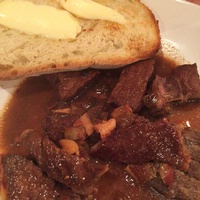 beer rather than in the more common red wine braise has a very different taste profile. Mellow, nutty, and richly flavored, this is a dish with which everyone who likes to cook (and eat) should be familiar. And one of the great attributes of carbonnade is that, despite the beer, it’s a wonderful partner for red wine!
beer rather than in the more common red wine braise has a very different taste profile. Mellow, nutty, and richly flavored, this is a dish with which everyone who likes to cook (and eat) should be familiar. And one of the great attributes of carbonnade is that, despite the beer, it’s a wonderful partner for red wine!|
Selection
|
Approx. Price |
Comments |
|
Clayhouse, Paso Robles (California) Petite Sirah “Red Cedar Vineyard” 2013
|
$23
|
Not as tannic as some Petites, this is a rich, berry-dominated red that both feels and tastes juicy. It shows excellent length on the palate, a real plus when paired with such a flavorful dish. |
|
Edmeades, Mendocino Ridge (California) Zinfandel “Perli Vineyards” 2013
|
$17 |
The best Edmeades Zin we’ve tasted since the idiosyncratic winemaker, Van Williamson, plied his trade there, this is a beautifully balanced but characteristically intense expression of the variety. It’s also quite a bargain, as it has the muscle to stand up to a dish like this one while never seeming hot or excessive. |
|
Laurel Glen, Sonoma Mountain (California) Cabernet Sauvignon “Counterpoint” 2013
|
$40 |
A classic Sonoma Mountain Cabernet, with firm tannins, plenty of cassis-like fruit flavor, and a taut structure. Not only did it hold its own with the carbonnade, it also contributed extra layers of flavor, making the pairing delicious because so seamless. |
|
Famille Perrin, Gigondas (France) “La Gille” 2013 (Imported by Vineyard Brands)
|
$39
|
Though showing plenty of fruit, this wine does also have an earthy, rustic edge, making it a bit of an outlier among the wines we’re recommending. Unlike some equally rustic wines we tried, its core of succulent red fruit flavor helped it stand out and so merited its inclusion here.
|
|
Spice Route. Swartland (South Africa” “Chakalaka” 2013 (Imported by Vineyard Brands)
|
$24 |
A blend of six grape varieties (Syrah, Mourvèdre, Petite Sirah, Carignan, Grenache and Tannat), this wine carries a Zulu name that refers to a South African spice mixture in which the whole is greater than the sum of its parts. That’s true here too, as the blend is an intriguing mix of elements—fruit (both red and black), sweet and savory spices, a lush texture but also a tight structure. That combination of different elements is what enabled it to pair so nicely with the carbonnade. |
